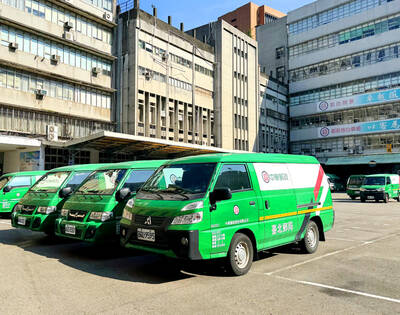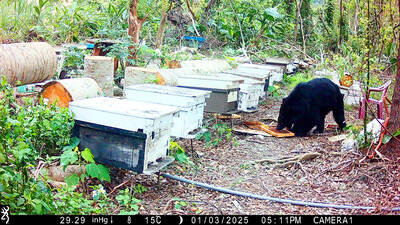Though still seen as a hero by some in Taiwan for waging war against communist China under the banner of the Chinese Nationalist Party (KMT), former president Chiang Kai-shek (蔣介石) has long been a divisive figure in the nation.
His role in the White Terror era and his imposition of martial law have led many to brand him a dictator synonymous with the authoritarianism that wary Taiwanese now equate with the rule in China.
Fears over increased Chinese influence have grown since 2008 under President Ma Ying-jeou’s (馬英九) KMT government, which has forged a rapprochement with Beijing.
Chiang’s authoritarianism has outweighed his Nationalist credentials and his image is wrapped up in that concern, with young people in particular feeling strongly that his memory should not be celebrated.
“Chiang was a dictator. For a long time, freedom of speech in Taiwan was suppressed,” said Peter Chu, 23, a graduate student at National Taiwan University of Science and Technology. “Why should his statues be allowed to remain on any campus?”
“There have been calls for removing the statue [at my school], but the school authorities have done nothing about it,” said student and former Anti-Curriculum Changes Alliance convener Chu Chen (朱震), 18, who attends the prestigious Taipei Municipal Jianguo High School. “Every year, graduates decorate the statue mocking it.”
Students most recently decked it out the figure in an E.T. costume, with a helmet and wings. The animosity is not all about avenging the past.
Chu Chen is part of a campaign against what protesters call “China-centric” changes to high-school curriculum guidelines by the ruling pro-China KMT government.
He said youngsters’ anti-Chiang sentiment stems from the same drive: to take control of their own destinies.
“Chiang Kai-shek was a symbol of Taiwan’s past authoritarian rule. So is the new curriculum, which has forced us into obeying something we think is not right. The objection shares the same reason,” he said.
As leader of the KMT, Chiang fought a civil war in China and with the Chinese communists before being defeated and fleeing to Taiwan in 1949, where he imposed martial law. Chiang died in 1975.
Political opposition was banned and newspapers barred until martial law was eventually lifted in 1987.
However, it was an incident 50 years previously that first sparked Taiwanese resentment.
The 228 Incident, an uprising that began on Feb. 27, 1947, saw troops brutally quell an anti-government uprising triggered when an inspector beat a woman selling untaxed cigarettes in Taipei. Thousands of people were tortured and killed during the subsequent White Terror era.
Though Chiang was not in Taiwan for the 228 Incident, he has been held responsible for ordering the army to step in, and it has become an easy symbol for the animosity against him, which becomes particularly pronounced on the anniversary.
There were a record 30 attacks on statues of Chiang on Feb. 28 this year, with one beheaded and others smeared with red paint.
“Many of the attacks [on statues] were done by students, who believe Chiang is the icon not only of the [KMT’s] authoritarian rule of Taiwan, but also of a regime from China,” said Shih Cheng-feng (施正鋒) of National Dong Hwa University. “As Chiang’s statues are on every corner, they have easily become the targets of growing anti-China sentiment.”
Chiang’s public profile was steadily eroded under the Democratic Progressive Party (DPP) administration from 2000 to 2008, with statues removed and street names changed.
Traditionally Beijing-skeptic and pro-independence, the DPP changed the name of the nation’s main airport from Chiang Kai-shek International Airport to Taiwan Taoyuan International Airport and dropped his memorial day as an official holiday.
Schools were asked to stop singing songs portraying him as a “national savior” and “great world leader.”
However, some iconography survived. In March, Tainan Mayor William Lai (賴清德) of the DPP ordered the removal of Chiang statues from 16 schools.
“Chiang’s statues have political implications and are very controversial. They should be removed,” Lai said.
They were sent to a museum in Taoyuan which also houses Chiang’s mausoleum. In recent years, it has become a graveyard of unwanted Chiang icons, with 218 statues currently on display. Officials there expect numbers to rise as more are discarded.
Three Taiwanese presidents, including Ma, have apologized to the families of the 228 Incident victims. They were given compensation after a government investigation said that Chiang “should bear the biggest responsibility” for the incident.
Yet, bitterness remains.
“The transition of justice has not been completed,” Taipei-based rights lawyer Lai Chung-chiang (賴中強) said. “Despite a democracy, the remnants of the authoritarian ruling, like Chiang’s statues, still stand.”

SHIPS, TRAINS AND AUTOMOBILES: The ministry has announced changes to varied transportation industries taking effect soon, with a number of effects for passengers Beginning next month, the post office is canceling signature upon delivery and written inquiry services for international registered small packets in accordance with the new policy of the Universal Postal Union, the Ministry of Transportation and Communications said yesterday. The new policy does not apply to packets that are to be delivered to China, the ministry said. Senders of international registered small packets would receive a NT$10 rebate on postage if the packets are sent from Jan. 1 to March 31, it added. The ministry said that three other policies are also scheduled to take effect next month. International cruise ship operators

NUMBERS IMBALANCE: More than 4 million Taiwanese have visited China this year, while only about half a million Chinese have visited here Beijing has yet to respond to Taiwan’s requests for negotiation over matters related to the recovery of cross-strait tourism, the Tourism Administration said yesterday. Taiwan’s tourism authority issued the statement after Chinese-language daily the China Times reported yesterday that the government’s policy of banning group tours to China does not stop Taiwanese from visiting the country. As of October, more than 4.2 million had traveled to China this year, exceeding last year. Beijing estimated the number of Taiwanese tourists in China could reach 4.5 million this year. By contrast, only 500,000 Chinese tourists are expected in Taiwan, the report said. The report

The Forestry and Nature Conservation Agency yesterday launched a gift box to market honey “certified by a Formosan black bear” in appreciation of a beekeeper’s amicable interaction with a honey-thieving bear. Beekeeper Chih Ming-chen (池明鎮) in January inspected his bee farm in Hualien County’s Jhuosi Township (卓溪) and found that more than 20 beehives had been destroyed and many hives were eaten, with bear droppings and paw prints near the destroyed hives, the agency said. Chih returned to the farm to move the remaining beehives away that evening when he encountered a Formosan black bear only 20m away, the agency said. The bear

Chinese embassy staffers attempted to interrupt an award ceremony of an international tea competition in France when the organizer introduced Taiwan and displayed the Republic of China flag, a Taiwanese tea farmer said in an interview published today. Hsieh Chung-lin (謝忠霖), chief executive of Juxin Tea Factory from Taichung's Lishan (梨山) area, on Dec. 2 attended the Teas of the World International Contest held at the Peruvian embassy in Paris. Hsieh was awarded a special prize for his Huagang Snow Source Tea by the nonprofit Agency for the Valorization of Agricultural Products (AVPA). During the ceremony, two Chinese embassy staffers in attendance